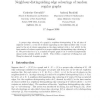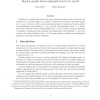59 search results - page 6 / 12 » The Chromatic Number of Random Regular Graphs |
COMBINATORICA
2008
13 years 7 months ago
2008
A random geometric graph Gn is constructed by taking vertices X1, . . . , Xn Rd at random (i.i.d. according to some probability distribution with a bounded density function) and...
COMBINATORICS
2004
13 years 7 months ago
2004
Consider random regular graphs of order n and degree d = d(n) 3. Let g = g(n) 3 satisfy (d-1)2g-1 = o(n). Then the number of cycles of lengths up to g have a distribution simila...
CAAN
2007
Springer
14 years 1 months ago
2007
Springer
In the recently introduced model for cleaning a graph with brushes, we use a degree-greedy algorithm to clean a random d-regular graph on n vertices (with dn even). We then use a d...
COMBINATORICS
2006
13 years 7 months ago
2006
A proper edge colouring of a graph is neighbour-distinguishing if for all pairs of adjacent vertices v, w the set of colours appearing on the edges incident with v is not equal to...
RSA
2006
13 years 7 months ago
2006
Motivated by a problem that arises in the study of mirrored storage systems, we describe, for any fixed , > 0 and any integer d 2, explicit or randomized constructions of d-r...


